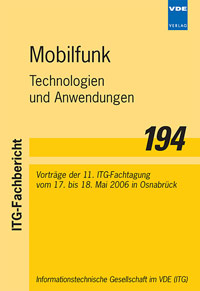Overview on UMTS HSDPA and Enhanced Uplink (HSUPA)
Conference: Mobilfunk - Technologien und Anwendungen - 11. ITG-Fachtagung
05/17/2006 - 05/18/2006 at Osnabrück, Germany
Proceedings: Mobilfunk
Pages: 6Language: englishTyp: PDF
Personal VDE Members are entitled to a 10% discount on this title
Authors:
Zhao, Liang (Communication Networks, University of Bremen, Otto-Hahn-Allee NW1, 28359 Bremen, Germany)
Abstract:
HSDPA, an extension of UMTS, provides data rates of theoretically up to 14.4 Mbit/s. Realistically, data rates for each user of around 2 Mbit/s are expected. In comparison to UMTS (Rel. ’99) the scheduling is moved from the Radio Network Controller (RNC) to the Node B, adaptive Modulation and Coding (AMC) applied and a hybrid ARQ (HARQ) is implemented. HSUPA introduces similar features for the uplink: shorter TTI, HARQ and Node B controlled scheduling provide the improved performance on the enhanced uplink with higher data rates (theoretically up to 5.76 Mbps), lower latency and the potential to serve more active users. In this paper, we give an overview on the main features and the principles of HSUPA and HSDPA. The focus is laid on HSUPA and the possible approaches to simulate the network performance with HSUPA and different scenarios to deploy HSUPA in existing networks. At end of the paper a summary of simulation examples is given.


